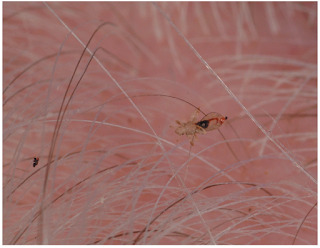Head Lice
Introduction
Infestation by head lice (Pediculus humanus capitis) can occur at any time of the year and is mostly transmitted by head-to-head contact.
- It is most prevalent in children aged 4 to 11 years, especially girls.
Clinical Features
Many cases of head lice infestation are asymptomatic.
- Pruritus (intense itchiness) resulting from sensitisation to louse salivary or faecal antigens is the most common symptom (seen in approximately one third of patients).
- Persistent scratching can cause lesions, and this can give rise to secondary infections or swollen lymph glands or both.
Observation of live lice is diagnostic.
- Head lice are 1-4 mm long, and their colour ranges from nearly colourless (when they hatch) to reddish brown (after feeding).
NOTE: It should be remembered that an itching scalp in children is not always due to head lice. Inspection of the scalp should be made to check for signs of dandruff, psoriasis or seborrheic dermatitis.
Checking For Infection
Wet combing of the hair is a more reliable detection method than scalp inspection.- Parents can easily check for infection by combing the child’s hair over a piece of white- or light-coloured paper, using a fine-toothed comb (tooth spacing of <0.3 mm).
- The hair should be damp or wet to make the combing process easier and less painful. Also, dry hair can produce static that causes lice to be repelled from the comb, making detection less likely.
- After each stroke from the roots to the tips of the hair, the comb should be wiped on a white tissue or cloth.
- The hair should be combed one section at a time. The hair at the nape of the neck and behind the ears should be thoroughly checked. These areas are preferred by lice because they are warm and relatively sheltered.
- After treatment of affected family members, parents should check whether the treatment has been successful by doing detection combing on day 2 or 3 after completing a course of treatment and again after a further interval of 7 days. More checks will be needed if there are further symptoms or when infection is known to have occurred in other children at school or playgroup.
Management
Only those individuals in whom a live head louse has been found should be treated. Treatment options include
Physical insecticides
- Generally now considered "first line" as they have few adverse effects, and lice do not develop resistance to them.
- Examples include dimeticone and isopropyl myristate in cyclomethicone solution.
- Treatment should be repeated after 7 days.
Wet combing
- The recommended regimen for wet combing treatment is 4 sessions spaced over 2 weeks (on days 1, 5, 9 and 13), continued if necessary until no full-grown lice have been seen for 3 consecutive sessions.
- It will take 10 minutes to complete the process on short hair but 20-30 minutes for long, frizzy or curly hair.
- 2 combing procedures are recommended at each treatment session.
Chemical insecticides
- Resistance to pyrethroids (pyrethrins and permethrin) and malathion is a growing concern, and geographical variability exists in the prevalence of pediculicide resistance.
Complementary therapies
- There are a variety of complementary therapies, many derived from herbs. These include tea tree oil, coconut oil, eucalyptus and lavender-based products. Homeopathic remedies are also available.
- There are many home remedies, including the copious use of hair conditioner, baby oil, petroleum jelly and diluted white vinegar.
- Electric combs have also been advocated.
- The problem with all these treatments is lack of evidence of effectiveness. Some of them can cause skin irritation. Use of these is not generally recommended.
NOTE:
- Based on current evidence, it seems dimeticone is the treatment of choice.
- Egg shells are not removed by using insecticides. Patients need to be reassured that the presence of egg shells does not mean treatment failure.
- Insecticides should never be used prophylactically, since this may accelerate resistance. Treatment should be reserved for infected heads.
Other Action Required
Head lice live for up to 48 hours off the head, but the eggs can survive for up to 10 days.
- Wash pillow cases and bed sheets on hot cycle or place in a clothes dryer for 15 minutes.
- Soak combs and brushes in hot water (over 60°C) for at least 30 seconds.
- Place items that cannot be washed (e.g. hats) in a sealed plastic bag for at least 2 weeks.
External Links
- Comparison of wet combing with malathion for treatment of head lice in the UK: a pragmatic randomised controlled trial, 2000
- Treatment of head louse infestation with 4% dimeticone lotion: randomised controlled equivalence trial, 2005
- A highly efficacious pediculicide based on dimeticone: Randomized observer blinded comparative trial, 2008



Comments
Post a Comment